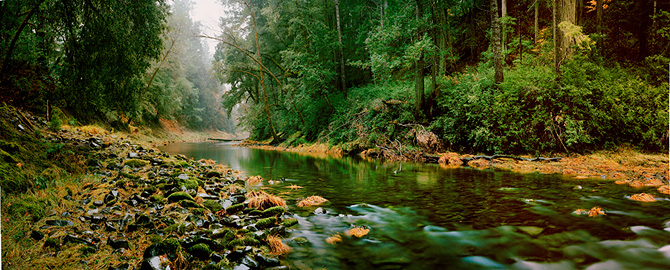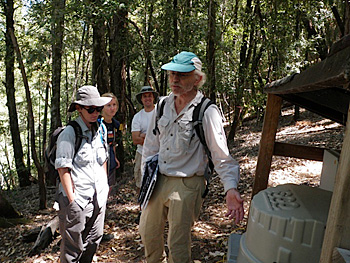Eel River Observatory seeks clues to watershed’s future

University of California, Berkeley, scientists will receive $4,900,000 over the next five years to study the nearly 10,000 square kilometer Eel River watershed in Northern California and how its vegetation, geology and topography affect water flow all the way to the Pacific Ocean.
What the researchers uncover will help improve global climate models and modeling tools that can be used by state or regional decision makers to guide planning. Their discoveries may eventually allow scientists to predict the impact of changing climate and land use on future droughts, floods and supplies of water for drinking and agriculture.
Funded by the National Science Foundation, the Eel River Observatory is one of four new Critical Zone Observatories that received grants late last year, bringing the total number of such observatories to 10. All focus on the so-called “critical zone”: the thin veneer of Earth, from the bottom of the groundwater to the tree tops, that is critical to aquatic and terrestrial life as the source of fresh water and site of soil formation from rock.
The Eel River is increasingly under pressure because of illegal marijuana cultivation, wine grape growing and other uses that extract water from the river and threaten one of the state’s largest Coho salmon runs. In addition, warming waters in recent years have led to outbreaks of blue-green algae that produce enough toxins to kill dogs that drink the water. The river is currently stressed by the driest winter in decades.
“Whatever the agricultural use in the future, we will see increasing demands on a decreasing water resource,” said observatory director William Dietrich, UC Berkeley professor of earth and planetary science and an expert on the processes that shape landscapes.

Other UC Berkeley faculty members involved in the new project include professors Jill Banfield and Inez Fung of earth and planetary science and of environmental science, policy and management; professor Jim Bishop of earth and planetary science; assistant professor Stephanie Carlson and professor Mary Firestone of environmental science, policy and management; professor Mary Power of integrative biology; and assistant professor Sally Thompson of civil and environmental engineering.
“The critical zone provides most of the ecosystem services on which society depends, such as clean water, food, nutrients, soil and carbon storage,” said Roger Wakimoto, NSF assistant director for geosciences. “Researchers at the new CZO sites will investigate the past evolution and present state of the critical zone to predict how Earth’s surface will evolve in response to future human activity and to climate change. The results will provide the scientific basis for decision-making on how humans can best mitigate, adapt and respond to both slow and abrupt environmental changes.”
From Hydrowatch to Critical Zone Observatory
For more than 20 years, Dietrich and other UC Berkeley scientists, including river ecologist Mary Power and atmospheric scientist Inez Fung, have studied the Eel River watershed within the Angelo Coast Range Reserve, part of the University of California’s Natural Reserve System. A 2006-2010 project called Hydrowatch, funded by the W. M. Keck Foundation, allowed geologists, biologists, climate scientists, and chemists to place sensors over a small portion of the watershed to measure soil and rock moisture, water transport in trees and transpiration from leaves, in essence tracing the water and dissolved minerals and gases as they moved through the mixed hardwood-conifer ecosystem.
“The Keck Hydrowatch grant got us following the water, thinking about how topography affects the return of moisture to the atmosphere, and about the need to look inside hillslopes to understand atmospheric moisture, river flow and chemistry, ecosystems dynamics, and coastal ocean productivity,” Dietrich said. “This NSF funding will allow us to expand our research to the entire Eel River watershed, totaling nearly 10,000 square kilometers, and begin to look at the neighboring Russian River watershed.”
Dietrich refers to the water, energy, dissolved minerals and gases, sediments and organisms that move through landscapes as “currencies,” analogous to the money that flows through a country’s economy. The Eel River Observatory will focus on how the soil, forest and river “economy” interact with these currencies, including determining the flow maintained in rivers through drought, and the delivery of nutrients to the sea. Of particular interest is the so-far unexplored landscape beneath the hillside surface and below the soil mantle.
“Until now, we have been focused on this hillside in the Angelo Reserve, finding out how hills determine the return of gases to the atmosphere through plants, the amount of water available to plants and how much water is released to the stream,” he said. “Now we will begin to look at how hillside dynamics influence what is delivered to the ocean, and how coastal productivity may be influenced by stream dynamics.”
Key questions include:
- How does the underlying rock affect how much water is stored underground for plant use, and how might that affect plants’ susceptibility to seasonal drought and long-term climate change?
- How do underground microbes influence gases – oxygen, carbon dioxide, and hydrogen sulfide – and dissolved minerals available to plants through their roots?
- How does hillside storage of water affect the amount of water in the streams during California’s dry summers?
- Is there a tipping point beyond which climate change and land use change will irreversibly alter the river and coastal ecosystem?
“With anticipated increases in climate extremes, especially extended drought, and accelerating societal demand for water, we will focus on filling the gaps in our knowledge that not only inhibit our ability to forecast the direction of future change in the watershed and its currencies, but even the magnitude of that change,” Dietrich said.
RELATED INFORMATION
